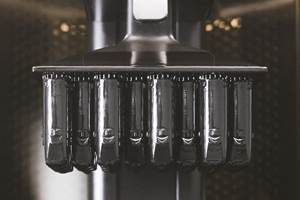Arburg Opens Faberlab Additive Center in Italy
The goal for the center is to demonstrate the potential of industrial additive manufacturing to prospective and existing customers of 3D printing technology on real machines.
Dr. Didier von Zeppelin, an expert from Arburg, explains the potential of Arburg Plastic Freeforming on the two freeformers directly. Photo Credit: Arburg
The “Faberlab powered by Arburg” Additive Center has officially opened. The center at Faberlab is a service provider for industrial additive manufacturing (AM), offering companies in the region an opportunity to familiarize themselves with additive machines from Arburg and innovatiQ in practical situations.
The opening follows a year-long planning and development phase for the factory in which the two companies will collaborate at Faberlab’s Origgio location in Milan, Italy. The aim is to demonstrate the potential of industrial AM to prospective and existing customers of 3D printing technology on real machines. A freeformer 200-3X, a high-temperature freeformer 300-3X and an innovatiQ TiQ 5 printer with a large build chamber for processing high-performance thermoplastics is available at Faberlab.
It is said customers benefit from the close collaboration between Faberlab and Arburg, and the expertise the two companies have pooled. The knowledge surrounds not only the technology itself but also services related to industrial AM and across the entire value chain from development to production. This includes rapid prototyping, component design and training.
According to Arburg, until now, no other center in Italy has been able to offer this expertise to companies, research institutes or training facilities. Arburg is providing a freeformer 200-3X, a high-temperature freeformer 300-3X and an innovatiQ TiQ 5 printer with a large build chamber for processing high-performance thermoplastics. Ivan Panfiglio, manager for additive manufacturing in Italy, is the point of contact at Arburg for customers of this technology.
This pilot project is based on the Arburg Prototyping Center (APC), which the company operates at its headquarters in Lossburg as well as at its branches in the USA and China. Now, customers can have benchmark components manufactured and materials qualified in Italy as well. Having strategically expanded the reach of its AM activities in this way, Arburg can now specifically meet local expectations and cater to the needs of the Italian market as a whole. The on-site team is able to support Freeformer and TiQ customers even faster and in a more specific, practical way.
Faberlab, in turn, has developed high-caliber expertise and knowledge in recent years through its work for the mechanical engineering, medical technology, aerospace, automotive and plant engineering industries. It now brings this know-how to the collaboration.
To help potential users become more familiar with the technology, existing and prospective customers are given the opportunity to participate in technology training courses and work with the machine themselves on-site. The center is also equipped with laser cutting machines, formlabs and cutting edge digital manufacturing technologies that enable the object being manufactured to have a customized additive design.
“3D technology and its reach is of fundamental importance at a time when companies need innovations to reduce the time and cost required to realize projects,” says Dr. Victor Roman, Arburg managing director. “By the same token, the partnership developed with Faberlab is an integral part of this process and an element that we consider strategic for the Italian market as a whole."
- Learn more about Arburg’s Freeformer 200-3X and Freeformer 300-3X machines which are both designed as open systems utilizing the company’s Plastic Freeforming process for custom-configured additve manufacturing. The system is said to meet individual user requirements by adjusting slicing, droplet size and process regulation to influence the layer-by-layer build process utilizing a broad range of materials.
- Check out this product post about the Arburg Freeformer 750-3X 3D which provides more space inside the build chamber for larger components. It is well suited for the rapid series production of large components or several articles per construction order.
Related Content
Large-Format “Cold” 3D Printing With Polypropylene and Polyethylene
Israeli startup Largix has developed a production solution that can 3D print PP and PE without melting them. Its first test? Custom tanks for chemical storage.
Read MoreAM 101: Digital Light Synthesis (DLS)
Digital Light Synthesis (DLS) is the name for Carbon's resin-based 3D printing process. How it works and how it differs from stereolithography.
Read MoreWhat is Powder Bed Fusion 3D Printing?
Whether in metal or polymer, with a laser or an electron beam, powder bed fusion (PBF) is one of the most widely used 3D printing techniques.
Read MoreHow to Build 10,000+ Shot Molds in Hours
Rapid tooling isn’t so rapid when it takes days to 3D print a metal mold, and then you still must machine it to reach the necessary tolerances. With Nexa3D’s polymer process you can print a mold in hours that is prototype or production ready and can last for more than 10,000 shots.
Read MoreRead Next
Video: Intelligent Layering Metal 3D Printing at 3DEO
Contract manufacturer 3DEO delivers metal parts using Intelligent Layering, a binder jetting-like 3D printing process the company developed and operates internally. Here’s how it works.
Read MoreLooking to Secure the Supply Chain for Castings? Don't Overlook 3D Printed Sand Cores and Molds
Concerns about casting lead times and costs have many OEMs looking to 3D print parts directly in metal. But don’t overlook the advantages of 3D printed sand cores and molds applied for conventional metal casting, says Humtown leader.
Read MoreTo Improve Performance of Compression Molded Composites, Add 3D Printed Preforms
9T Labs' Additive Fusion Technology enables the manufacture of composite structures with as much or as little reinforcement as is necessary, using 3D printed continuous fiber preforms to add strength just where needed.
Read More











.png;maxWidth=300;quality=90)












